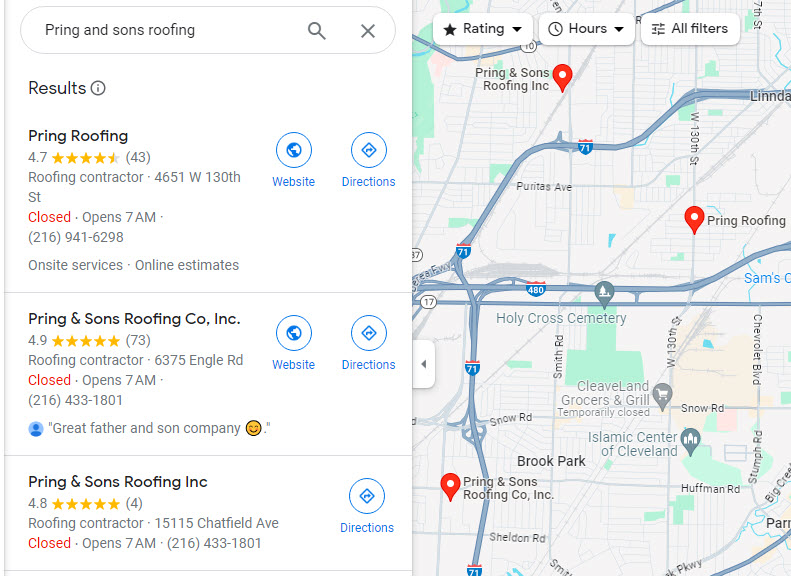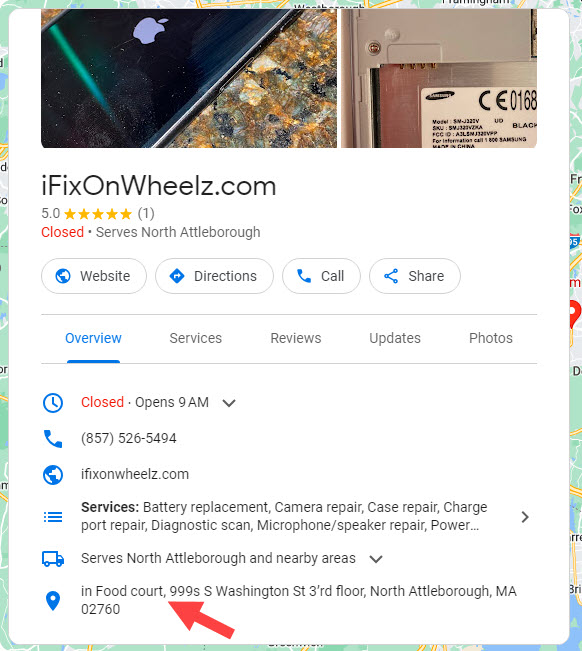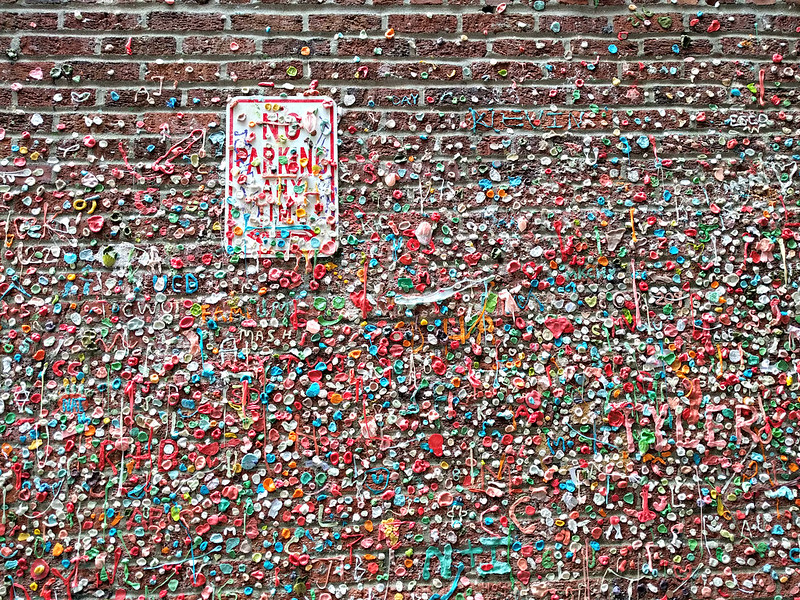Some businesses flout Google’s suggestions rules, moon their competitors, and are punished with great local rankings and plenty of business. How do they get away with it so often?
The reasons vary from case to case, but they’re always more specific than “duh” explanations like that “Google doesn’t care” (it doesn’t) or that some people play dirty pool (they do). I don’t claim to know exactly what goes into Google’s internal decision-making. But I have observed when a dubious Google Business Profile page is likely to be removed or fixed, and when it’s likely to linger and stink up the joint.
Why does that matter? You need to know what’s most likely to stick if you’re trying to scrape it off of your local map, and likewise if you’re trying to harden up your Google Business Profile so it doesn’t get mistaken for spam. The more you’re aware of Google’s blind spots, the more you’re aware of your blind spots.
Here are the factors that seem to make a spammy GBP page more likely to stick around and stay the way it is:
1. Using only one Google Business Profile page, rather than multiple pages. For a business to have its only GBP page removed can be a catastrophe for it. Google may hesitate to nuke it for that reason.
2. Spread-out GBP pages. Most true multi-location businesses fan out a little bit, so as to cover more of their service area or target area. If competitors don’t carpet-bomb one small area with multiple GBP pages, they’re a bit more likely to fly under Google’s (and competitors’) radar, whether they’re spamming the map or not.

3. Being claimed / owner-verified. It’s easier to get an unverified or soft-suspended GBP page removed from the map, rather than one that’s owner-verified. Even if your competitors use a totally shady address for their GBP page, as long as they have the ability to re-verify it at that address (by hook or by crook), then it will be much harder for you to get Google to remove it.
4. Using a residential address AND hiding the address on the GBP page. Google doesn’t really care (anymore) if someone uses a residential address, and neither do most competitors, customers, or business owners. Though it’s a case-by-case question, it’s a good idea more often than not. The trouble is that a GBP page that uses a home address is very vulnerable to the “Not open to the public” type of edit. Often that page is removed and its owner is compelled to re-verify at a different address or to hide the address and instead specify a service area. But that same page is much less likely to be removed if the address is hidden from the get-go.

5. Using an address that’s hard to falsify. When it’s an address with many renters or other occupants, or one that seems both commercial and residential, Google is more gun-shy and more likely to leave the GBP page alone, despite any sophisticated methods it may or may not have for ferretting out a bogus address.
6. Getting suspended and then reinstated. At some point Google seems to whitelist pages that may have run afoul of GBP policies and that may still not be following them to the letter. I’ve had a few cases in which on my client’s behalf I reported a bogus-address competitor, Google agreed with my edit and removed the competitor, and then a couple of weeks later the competitor returned to the map and at the same address. Then, after I reported the competitor a 2nd time, Google didn’t approve the edit and just let the GBP page stand. (Did Google make the wrong call the first time or the second time?) Through the appeal-and-reinstatement process, the page would have gone through several layers of scrutiny by Google support people, who may or may not have made the right call. If a page you once had removed is reinstated, you may be in for a real showdown.
7. No overlap in branding or NAP+W info. Let’s say your competitor has dotted the map with additional GBP pages that ostensibly are for a separate “brand,” even though you know they’re not and that it’s just a lead-gen scheme. If the branding on the site, the names, addresses, phone numbers, and possibly the websites are separate, Google is more likely to see 2 or more GBP pages as de facto separate brands, or at least Google won’t be able to tell the real one from the Potemkin Village. This is one of the oldest and best-known gray-hat local SEO moves, but that’s because it’s more likely than not to work.
8. Showing the GBP street address on the site. Google expects to see a business’s address on its site. If it’s on the site, the GBP page seems less likely to get pulled, legit address or not.

9. Citations on the basic sites. A GBP page that’s dangling out there by itself appears odd to Google, because most business owners try to hang their shingle in at least a few places online. A GBP page is more likely to stick around when it’s reflected by listings that pop up where Google expects them to pop up.
10. Reviews. A page with dozens or hundreds of Google reviews certainly can get removed from the map, but it’s somewhat less likely to be. (I have my theories as to why that is.) At the same time, Google’s just as likely as ever to approve edits to that business’s name.
11. Using a free Google-hosted site. As Tim Capper has documented, tying one of these to a GBP page makes Google less likely to throw it in the clink.
12. Competitors’ lack of persistence. Sometimes it takes months of waiting and a few different types of “suggest an edit” Google Maps complaints to get a spammy GBP page removed or even to get a spammy GBP name fixed. Often Google doesn’t let you know right away whether it agrees with your edits. But just because you haven’t gotten through doesn’t necessarily mean you won’t. Thinning the herd isn’t a one-time activity. If your competitors are persistent in spamming the map, you need to be persistent in reporting problems. It doesn’t need to take much time or become your new hobby, but if you don’t do it, Google typically will just ignore whatever your competitors are doing, at your expense.
On top of those, I’ve got a few possibly crackpot theories as to what else makes some spam stubborn. There may or may not be anything to these, and maybe in another blog post I can elaborate a little, but my basic list of speculative spam-stick factors includes:
- Age and historical data (does it seem to have been a relevant search result for years?)
- Choice of category (is the business not in a GBP category that’s rife with spammers?)
- Advertising (I got into this a little in a 2019 post)
- Customers’ photos (if customers upload photos of the place, isn’t it much more likely to be legit?)
- Faking one thing rather than everything (if a competitor’s address and name and hours are inaccurate, and maybe the reviews are also fake, then there are more ways to draw scrutiny and not pass it)
- Not changing GBP info often (if a business owner picks an address and a name and a category and so on and sticks with them – whether compliant or not – Google may conclude that he or she isn’t trying furiously to “crack the code”)
What do I suggest you do about all of that? Nothing that I haven’t recommended already. Don’t spam the map, if you can possibly avoid it (there are times you need to fight fire with fire while trying to bring down the temperature, paradoxically). Do your Google Maps “spam patrol,” with the above-mentioned spam-stick factors in mind. Be organized about your spam reporting, experiment a little, and maybe get a backup dancer or two. Don’t fixate on the map, and instead spend most of your time on your organic SEO, which will help you both on and off the map.
What kind of Google Maps spam is littering your local market? What “fake it ‘til they make it” strategy do your competitors seem to use? What’s worked to counteract it, if anything? Leave a comment!

We have a competitor whose address is the post office. Have reported it with business redressal form several times but it’s still there. Is there anything else I can do.?
A few questions:
1. Is the address showing publicly?
2. Which “suggest an edit” options (i.e. reasons for requesting removal) have you used?
3. How long ago did you first take a crack at it?
4. Have you had others send in reports, too?
A multi-billion dollar company with some of the smartest people on earth working there, as well as some of the best AI in the world, and some goofball from Anytown, America can game them, over and over. It’s a bit embarrassing, no?
Well-put, Andy. It’s like an elephant trying* to stomp mice. (*Or at least just walking around and stepping on a few by accident.)